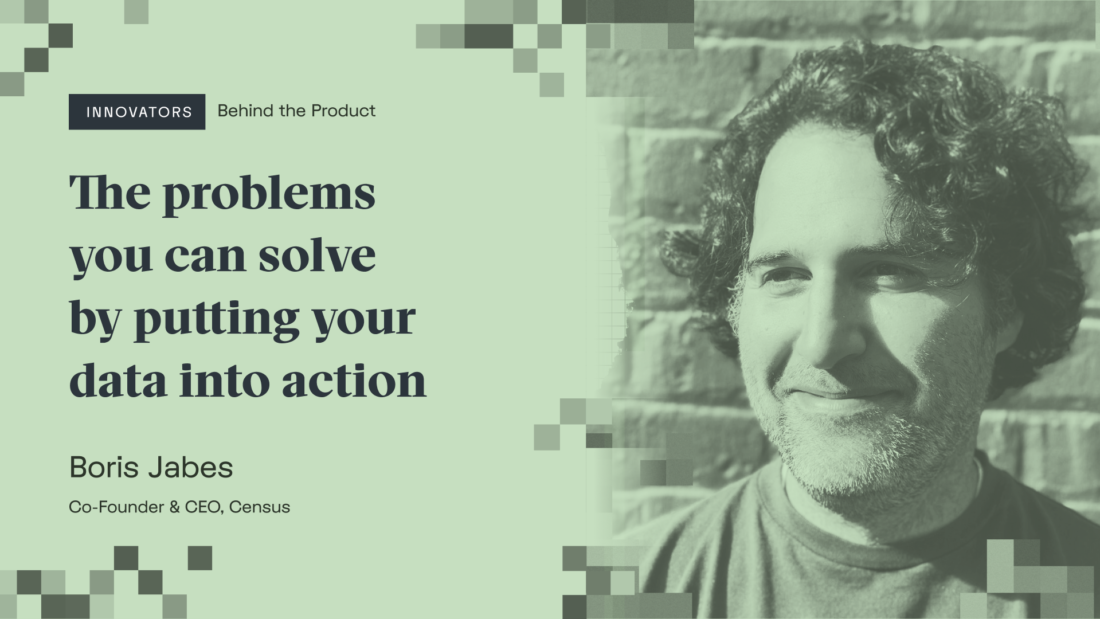
Boris Jabes on the problems you can solve by putting your data into action

Boris Jabes’ passion for solving problems can be traced back over 30 years. While most 80s kids fell into computers by way of video games, he was having fun crunching together object-oriented scripts in HyperCard.
Today, as the co-founder and CEO of software company Census, which offers reverse ETL (extract, transform, load) data functionality as a service to operationalize companies’ analytics, Boris is focused on helping his customers put their data to use to run their businesses better. It’s something he’s seen emerge as one of the biggest problems facing all manner of companies, so, naturally, the gig has him excited.
We spoke to Boris about what, exactly, he thinks still needs fixing in the data world, how Census is going about helping, and what companies of all sizes can unlock today by investing in the modern data stack.
This interview has been edited for clarity and brevity.
From the beginning of your career to now, what are the ways you’ve seen the industry change how it talks about and treats data—as both a concept and a commodity?
Sure, there have been various times in our industry when folks would clamor, “Now’s the time of data,” or what have you.
Thirty years ago, software was mostly about individual productivity: “Hey, I can do spreadsheets faster this way than by hand.” In those days, data was rarely collected and analyzed at scale.
And then we moved to the cloud, which added collaboration advancements to productivity software. Along the way, it became possible to collect data easier—and the amount that was getting collected became large. Then, about 15 years ago, we started to hear lots of talk about big data, Hadoop, etc. The idea was that if you had petabytes of data, like Walmart, you could somehow transmogrify that into value, but most of the efforts didn’t pan out. I think we were a little exuberant.
Today, as SaaS matures, we’re getting more sophisticated and effective with this data. We’re starting to use data to improve user experience, to provide better support to customers, to target advertising and marketing better, and even to guide where sales spends its resources.
Of course, the way some of the big tech companies have handled data in recent years has made consumers reluctant to share their data lest it drives nefarious behavioral modification. But the majority of SaaS products today are trying to use the data they have to improve their software for the benefit of their users. Though I think we still have some work to do before we see companies reach their full potential, data is more valuable than it’s ever been. And there’s more of it than ever.
I guess that makes companies like Census pretty important today. Can you tell us a bit more about the kinds of problems you wanted to solve when you started the company?
About ten years ago, I started my first company, Meldium, which was a service to centralize and federate identity and login for services across the web. After we sold and became part of a larger company, I started to notice data discrepancies and data missing in various parts of the organization. I would work with marketers who didn’t seem to know what our users were doing in the product or salespeople who didn’t even know what they should write to someone. I would think, “How do you not know? We have the data.” They would invariably reply, “I don’t have the data,” because everyone lives in their own silo. They live in Salesforce, they live in Zendesk, they live in whatever tool they’re using.
That’s when I knew I had a new problem to solve and a pre-existing software model from Meldium to use as inspiration. Key data like customer data should be centralized and federated in these organizations, not just copied around ad-hoc everywhere.
And that’s what led to the creation of Census. We connect to your data warehouse and syndicate the data out into all your SaaS products, so your Zendesk, Salesforce, or HubSpot use the same centralized data from the warehouse. And not only is the data fuller and richer across those platforms, but it’s in the hands of all the people who need it, not just the analytics team. Every business benefits from operationalizing its data from a single, trusted source of truth.
That was about four years ago. How far has Census come in its goal to help move the industry toward this centralized data direction?
I’m definitely a glass-half-empty person, so the job is never done. I think we’ve only accomplished a fraction of what we set out to accomplish, which is good. It’s not time to retire anytime soon.
I think the biggest immediate gains our 300+ customers have had from using our platform is having their analytics work be seen and used by more people in the company. Most of them still have plenty of data silos, though! I think we’re still a very long way away from our goal of centralizing and federating all data across a company. But broadening access to analytics—the work that data teams do to understand active users, or what signals lead to a paying customer, or how to serve the most valuable customers in your company—all of that is a great start.
Before Census, what I found is most companies were either not doing that work, or if they did that work, it was showing up in a chart or in a list somewhere, and maybe someone looked at it. The ability to just put that in the hands of a salesperson, a marketer, a support team, or a customer success team is huge.
“You can’t really automate your business with a chart… Every business benefits from operationalizing its data from a single, trusted source of truth.”
I remember the data science team from one of our early customers had done a bunch of work to derive a score that determined who their VIP customers were. It went beyond looking at who was paying the most; this was a fine-grained, multi-dimensional query that generated the score. One of the simplest ways that Census helped them transform as a business was putting that score in the hands of the support team, right in the ticketing system. The result was giving that team the ability to just write a little rule in Zendesk to put that data into use: If they’re VIP, I want them in a different queue and I want a different SLA. Overnight, it changed the way they operated the support team.
In terms of hitting the full goals of Census and getting more of our customers to adopt a single source of truth that is federated to every part of the company, it will take time. Some of that is like human transformation, and some of that is systems. It’s a journey.
Some of what you’re describing are the functions of operating a modern data stack, particularly the part about centralizing data to a cloud data warehouse. How do you talk to companies of different sizes about the importance of investing in a modern data stack and also making sure that stack includes reverse ETL like Census?
What makes the cloud data warehouse compelling for every company of any size, literally from a three-person startup all the way to a 500,000-employee multinational, is that it has infinite storage scalability. So you can put everything in your company in a warehouse for a reasonable price.
And when it comes to paying for the computing of that data, you only have to do that when you want to derive insights. For smaller companies, that could be less often. So this is a very efficient way to store, analyze, and compute all your company’s data.
What you stack on top of the warehouse are technologies and services that make the warehouse and its data possible to use and access without having to spend engineering time.
Products like Fivetran, for example, allow you to easily ingest data into a data warehouse. So now you can automatically load data into the warehouse from Salesforce or many other places. After that, you want to clean the data, reason about the data, and derive insights from the data. A popular tool for these jobs would be dbt. And then, of course, when you get all these insights, what do you do with them?
Before Census, the modern data stack was missing a piece. All you could do with insights was make a picture with business intelligence tools like Mode and Tableau. Don’t get me wrong, it can be helpful to be able to see the revenue, the most active users by organization, or a count of users by organization. But that left a lot of value on the table. You can’t really automate your business with a chart.
With Census and the modern data stack, you can go beyond business intelligence toward what we call operational analytics, which is the process of taking analytics from the warehouse and putting them into the systems that operate the business.
Now you can have more applications take advantage of that data with products like Mixpanel that can better understand the full picture. Users are now plugged in at the end of this data refinery.
“With the modern data stack, I think we’re moving in the direction of organizations using best-of-breed tools that are going to allow for the best experiences.”
So there is a wide collection of benefits from investing in a modern data stack, especially when it includes Census. And unlike other legacy database configurations, it’s one of those rare, beautiful pieces of architecture where you don’t have to graduate out. You can start with this when you’re a tiny company and you’ll never have to graduate, which is really nice.
As point-to-point data warehouse connection features start to appear inside various data tools, what is your take on why using a product like Census is still superior?
So if every app wants to build its own direct connection, it can do that. Zendesk and Salesforce are connected using native integrations, and they’ve had that for a long time. But these integrations are often very limited because doing it right requires the equivalent of a whole product. You have to manage all these tremendously subtle things that can go wrong. Like, how do you map time across different databases and different applications, for instance?
Once the integration is built, how do you monitor that data is flowing properly? How do you alert the teams that are responsible when something goes wrong? How do you make sure data is moving incrementally in order to go fast and save on costs? How do you log everything that occurred so people can understand where the failures occurred? It’s one of those things where writing these on day one is relatively easy. But when you try to make it work at scale with every one of your customers, you’re just going to find it’s hard to do it as well as a service whose sole focus is building these integrations.
You don’t need to take my view on this. I mentioned that Zendesk and Salesforce have an integration. But guess what? People who really needed to use these things together turned to products like MuleSoft and Boomi instead of using the native connection.
With the modern data stack, I think we’re moving more in the direction of organizations using best-of-breed tools that are going to allow for the best experiences. For example, I remember talking to someone at Mixpanel once about how you use the modern data stack to bring all your applicant tracking data into Mixpanel to analyze your talent funnel. Why? Because it’s superior to the analytics built into the majority of applicant tracking systems. That, to me, is a really good metaphor for where we’re going.
And the last thing I’ll say is that relying on a bunch of point-to-point connections lacks the single-source-of-truth rigidity that a hub-and-spoke architecture–where the warehouse is the true center–promotes.
I’m going to bookend this by asking: How do you think data will be viewed or treated even more differently in the next decades of your career?
I would expect our world to become even more software-led. Even your furniture company is going to start thinking about software. That’s going to mean even more data than we have now. And so I think we’re still, again, in the early days of that process. There’s still, of course, more and more moving to the cloud. Two-thirds of data warehouses are still on-prem. So there’s still a lot of work ahead of us to make the transition to the modern data stack.
From there, we’re going to see more and more parts of companies not just have access to that data, but be able to take action with that data, be data-savvy, and think about how to maximize their leverage in the business. I think of my life’s mission as really maximizing end users’ autonomy and leverage. Census is an amazing tool for leverage. Today if you’re a RevOps professional or an analyst, you can use Census, and with a couple of clicks, you’ve taken your idea and spread it out to hundreds of your teammates.
Not enough people see things this way today, but as more folks discover the modern data stack, I think they’ll inevitably start to think, “Now that there is a central data store that I can trust, I want to do more with it. I want to explore more ideas. I want to start experimenting.” There is virtually zero A/B testing in the world of sales, for example. But why not? Some of these things are hard to do, but as we hit larger and larger scale, and as we become product-led and software-led, the numbers are going to get big enough that you can actually run these kinds of experiments.
I think that’s where we’re going. There will be a lot of product features that we’ll have to build along the way to make that happen, so there will be plenty of problems to solve.
About Boris Jabes
Boris is the founder and CEO of Census, a service that helps companies sync customer data across business systems. Previously, he founded Meldium, a YC-backed password manager for teams, which was acquired by LogMeIn. Boris enjoys speaking about technology, helping other startup founders, and angel investing.
Gain insights into how best to convert, engage, and retain your users with Mixpanel’s powerful product analytics. Try it free.




